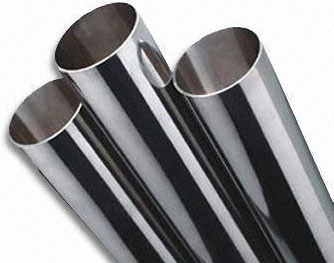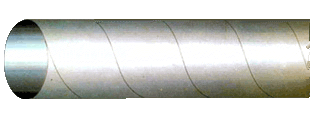|
Seamless pipe & seamed pipe
(1) seamless pipe
As an alternative process, spiral weld construction allows large diameter pipe to be produced from narrower plates
or skelp. The defects that occur in spiral welded pipe are mainly those associated with the SAW weld, and are similar
in nature to those for longitudinally welded SAW pipe. An additional problem with early spiral welded pipe was
poor dimensional accuracy, particularly out of roundness at the pipe ends. This led to problems of poor fit-up
during field girth welding. Spiral linepipe gained a poor reputation in some companies as a result of these early
experiences, and it was considered suitable only for low pressure applications such as water pipe. However, modern
spiral linepipe from a premium quality supplier is of a quality equivalent to straight seam welded pipe, and it has
been used extensively in Canada and Europe for high pressure gas pipelines in grades up to API X70.
-
 seamless pipe seamless pipe
|
|
(2) seamed pipe
Electric Resistance Welded (ERW) and High Frequency Induction (HFI) Welded Pipe
Originally this type of pipe, which contains a solid phase butt weld, was produced using resistance heating to make
the longitudinal weld (ERW), but most pipe mills now use high frequency induction heating (HFI) for better control
and consistency. However, the product is still often referred to as ERW pipe, even though the weld may have been
produced by the HFI process.
The defects that can occur in ERW/HFI pipe are those associated with strip production, such as laminations and
defects at the narrow weld line. Lack of fusion due to insufficient heat and pressure is the principal defect,
although hook cracks can also form due to realignment of non metallic inclusions at the weld interface. Because
the weld line is not visible after trimming, and the nature of the solid phase welding process, considerable
lengths of weld with poor fusion can be produced if the welding parameters fall outside the set limits.
In addition, early ERW pipe was subject to pressure reversals, a problem that results in failure in service
at a lower stress than that seen in the pre-service pressure test. This problem is caused by crack growth
during the pressure test hold period, which in the case of early ERW pipe was due to a combination of low
weld line toughness and lack of fusion defects.
(2-1) straight seam welded pipe
Welded pipe is a tubular product made out of flat plates, known as skelp, that
are formed, bent and prepared for welding. The most popular process for large diameter pipe uses a longitudinal
seam weld. Double submerged arc welded (DSAW) pipe is welded pipe whose longitudinal butt joint is welded in at
least two passes, one of which is on the inside of the pipe; the welds are made by heating with an electric arc
between the bare metal electrode. Pressure is not used. Filler metal for the welds is obtained from the electrodes.
For diameters above 36 inches, double seam welded pipe is specified as an alternative in API 5L. This has two
longitudinal seams 180° apart, formed by the SAW process. Finished pipes are normally 40 feet (12 m) and
occasionally 60 feet (18 m) long, depending on the capacity of the pipe mill and the ease of transport to the
pipeline.
-
 straight seam welded pipe straight seam welded pipe
(2-2> helical seam welded pipe
Coils are loaded on the decoiler of the Spiral Pipe machine. The strip is straightened and edges are milled to
desired joint geometry. The strip is guided into a forming station, where it is formed to produce a cylindrical
hollow body at a predetermined forming angle, ensuring proper welding gap between the abutting edges. Inside,
and later, outside welding is performed by an automatic submerged arc process.
Pipes are cut to a predetermined length by an automatic plasma arc cutting device. After accomplishment of inside
and outside welding, while on the production machine full length of pipe is examined by automatic ultrasonic unit
with the help of 8 probes, 4 for checking plate defects and 4 for checking welding defects. Flux and slag from
inside the pipes is cleaned. Pipes are inspected for any visual defects. Fluoroscopic inspection of pipes presents
the entire spiral seam on visual display for analysis of all the ultrasonic indications for defects, if any, in the
weld seam.
At the end facing machine both ends of pipes are machined to suit the joint to be used on the pipe line. Each end
is worked separately. Each pipe is hydrostatically tested to a given pressure as per API 5L specification or other
desired standard. At the end X-ray station radiographs are taken at weld seam for each pipe end to a distance of 4".
Every length of pipe is subjected to a rigorous check at the final stand - before it is accepted by the quality
control department.
-
 helical seam welded pipe helical seam welded pipe
|